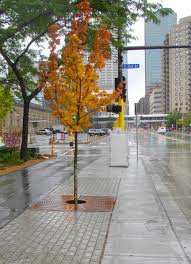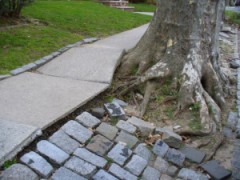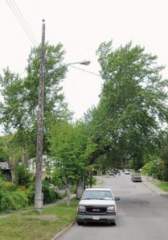The life of an urban tree in today’s day and age is a challenging one. Gone are the days of clean air and fresh water as a given. Space is often limited, be it for a tree’s canopy or root system. Even available soil is not always rich with nutrients. Yet we demand much from our trees, especially the ones in urban settings. Today, we are going to look at come of those challenges.
Challenges for Urban Trees

Let’s look at the tree planted on the boulevard of a busy street. This tree gives a touch of nature to our cityscapes, but its location is far from ideal for the tree. Pollution from passing cars and smog created from closed in city centres, do not make for healthy air for a tree to breathe. While trees filter out some of the pollutants and provide oxygen for us, air pollution can damage a tree’s leaves and the photosynthesis process. Not to mention, reducing a tree’s ability to defend itself against disease and other pests.
That same tree suffers by insufficient space too. More specifically, by a lack of space to grow. Trees need a certain ideal area for their root systems to form and develop. In urban settings, trees are often not provided with that space, resulting in stress and strain to the tree, as well as damage to surrounding sewer and septic systems, curbs, roads, walls and any other man-made structures that are nearby. The threat then becomes an insufficient base for the tree to support itself, potentially resulting in it falling over and damaging the surroundings. Plus, the tree simply will not thrive.
Aside from root space, aerial space is often limited as well. I don’t know how many times I have seen trees pruned for hydro wires and it always makes me sad. While all those branches and leaves provide aesthetic appeal, when they again compete with man-made structures, the tree just seems to lose. They are hacked out for power lines, pruned off-kilter for buildings or trimmed back over roadways. That leaves less space for a tree to perform its life functions of photosynthesis (remember that oxygen thing we ask trees to give us?). Plus, trees are left weakened from improper pruning, as well as creating stress points leaving them in danger of tree failure. Trees are also more susceptible to disease and pests when in a stressed state as well.
If that isn’t enough to contend with, urban trees are often planted in poor quality soil, are incorrectly staked (leading to damaged bark), are more prone to drought conditions (as there is less ground surface to pull water from and they are dependent on humans for watering), as well as under attack from humans ourselves vandalizing the trees that we so desperately need. Genetic diversity is often lower in urban settings, which can introduce problems when pests invade; for example, the emerald ash borer that is devastating Southwestern Ontario. And yet trees have been shown to improve air quality, absorb rainwater, reduce excess heat via shade, as well as reduce people’s stress levels and improve general moods. What is going on here? Trees give us so much and yet we throw challenges at them left, right and centre.
I think I need to hug a tree today. How about you?





You must be logged in to post a comment.